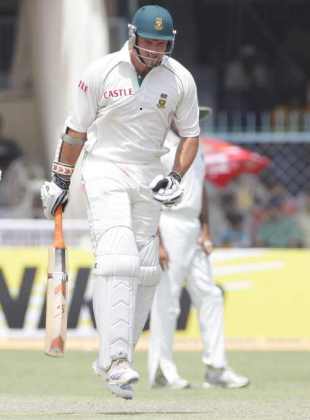|
|
|

Graeme Smith had scored quick runs in the first innings but failed to repeat the act in the second
© AFP
|
|
| |
After matching India blow for blow on the most alien of surfaces and conditions for two days, South Africa slipped up - decisively - in the first hour with the kind of display in the field that is usually associated with their rivals. It's India who are supposed to struggle with getting the tail out, but here South Africa allowed 46 runs to be added for the last wicket, and once that happened, they were always likely to struggle to get back on level terms.
Mickey Arthur had sounded the warning yesterday, saying they needed to get the last wicket "ASAP", but Dale Steyn and Makhaya Ntini, the bowlers who began the day, made a wayward start. They slipped quite a few down the leg side or full on the stumps.
Every streaky run by run, South Africa saw the match slip away at the hands of Nos. 10 and 11. Sreesanth and Ishant Sharma played the sort of irritating knocks that every opponent dreads. When they edged, they either found the gaps or one of the South African fielders in a rare inattentive moment, and when a mis-hit finally found two hands, it was off a no-ball. To rub salt into their wounds, an edged boundary would immediately be followed by an immaculate forward-defensive push. Smith tried all the bowling changes, the bowlers tried different things, but nothing worked until Sreesanth and Ishant had worked "some magic", as Sourav Ganguly had put it yesterday, taking the lead from 23 to 60. This is the second time in recent Tests that the India's last wicket has troubled South Africa - in
Johannesburg in 2006-07, Sourav Ganguly and VRV Singh had added 44 in another low-scoring game.
On a pitch which was misbehaving increasingly, South Africa's only chance to get back was to get quick runs. Scoring runs off every opportunity, before the inevitable unplayable delivery came along, was the only way to bat on a pitch like this one. That is exactly what Graeme Smith, Neil McKenzie, Hashim Amla, VVS Laxman, and Ganguly did to counter these conditions in the first innings.
In the second innings, though, the South African batsmen seemed to have forgotten the value of looking to score on this pitch. Much of this was to do with the Indian bowling and the condition of the pitch, but a lack of intent to score was conspicuous. Till this match, their gameplan against spin had worked perfectly well, but this pitch required something extra: some out-of-the-box adjustments, which usually comes with prior experience of batting on such pitches. Ganguly and Laxman did that, but the South African batsmen could not.
The Indian bowlers deserve credit too for bowling much better than they did in the first innings. They were the better equipped side to utilise the conditions, and they did it perfectly in the second innings. Mahendra Singh Dhoni's move to open with Harbhajan Singh was a smart one, as he had seen the fast bowlers spray the new ball around in the first innings. This time India made a controlled start, making sure a repeat of first innings wouldn't happen this time round. And when they saw a lack of intent from the batsmen, they knew it was only a matter of time when venomous deliveries would get the edges even if the batsmen had moved back and across in the most perfect manner.
| |
|
|
|
| |
| Till this match, their gameplan against spin had worked perfectly well, but this pitch required something extra: some out-of-the-box adjustments, which usually comes with prior experience of batting on such pitches |
| |
The lack of boundaries was the most conspicuous difference between South Africa's first and second innings. McKenzie had hit the third ball of the first innings for four; the first four in the second innings came in the ninth over. Smith played 66 balls before he hit his first boundary. Consequently, a partnership that lasted 11.3 overs hardly put India off their track as it added 26 runs only. All along the bowlers knew they would be able to bowl deliveries that would be vicious, which is what McKenzie and Amla got in quick succession.
The 16-over third-wicket partnership between Graeme Smith and Jacques Kallis fetched 38 runs, which just about got them past the deficit they had started with. During the course they kept getting unplayable balls, which only accentuated doubts in the heads of the two at the crease and others who followed.
For two remarkable days, South Africa had not let the pitch get to their heads, playing the ball and not the pitch. And although there was no shame in losing in conditions none of them would have encountered before, they might just have missed a trick on the final morning.
Sidharth Monga is a staff writer at Cricinfo
